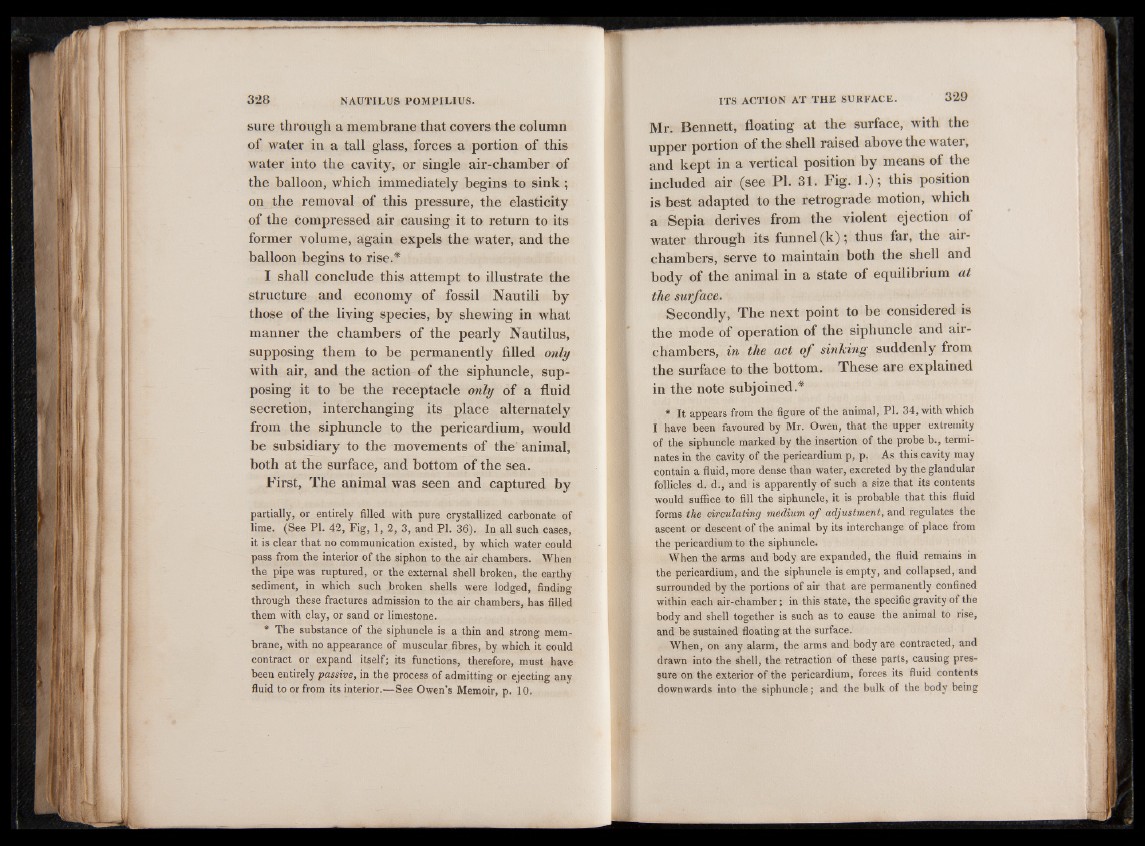
sure through a membrane that covers the column
of water in a tall glass, forces a portion of this
water into the cavity, or single air-chamber of
the balloon, which immediately begins to sink;
on the removal of this pressure, the elasticity
of the compressed air causing it to return to its
former volume, again expels the water, and the
balloon begins to rise.*
I shall conclude this attempt to illustrate the
structure and economy of fossil Nautili by
those of the living species, by shewing in what
manner the chambers of the pearly Nautilus,
supposing them to be permanently filled only
with air, and the action of the siphuncle, supposing
it to be the receptacle only of a fluid
secretion, interchanging its place alternately
from the siphuncle to the pericardium, would
be subsidiary to the movements of the animal,
both at the surface, and bottom of the sea.
First, The animal was seen and captured by
partially, or entirely filled with pure crystallized carbonate of
lime. (See PI. 42, Fig, 1, 2, 3, and PI. 36). In all such cases,
it is clear that no communication existed, by which water could
pass from the interior of the siphon to the air chambers. When
the pipe was ruptured, or the external shell broken, the earthy
sediment, in which such broken shells were lodged, finding
through these fractures admission to the air chambers, has filled
them with clay, or sand or limestone.
* The substance of the siphuncle is a thin and strong membrane,
with no appearance of muscular fibres, by which it could
contract or expand itself; its functions, therefore, must have
been entirely passive, in the process of admitting or ejecting any
fluid to or from its interior.—See Owen’s Memoir, p. 10.
Mr. Bennett, floating at the surface, with the
upper portion of the shell raised above the water,
and kept in a vertical position by means of the
included air (see PI. 31. Fig. 1.); this position
is best adapted to the retrograde motion, which
a Sepia derives from the violent ejection of
water through its funnel (k); thus far, the air-
chambers, serve to maintain both the shell and
body of the animal in a state of equilibrium at
the surface.
Secondly, The next point to be considered is
the mode of operation of the siphuncle and air-
chambers, in the act o f sinking suddenly from
the surface to the bottom. These are explained
in the note subjoined.*
* It appears from the figure of the animal, PI. 34, with which
I have been favoured by Mr. Owen, that the upper extremity
of the siphuncle marked by the insertion of the probe b., terminates
in the cavity of the pericardium p, p. As this cavity may
contain a fluid, more dense than water, excreted by the glandular
follicles d. d., and is apparently of such a size that its contents
would suffice to fill the siphuncle, it is probable that this fluid
forms the circulating medium o f adjustment, and regulates the
ascent or descent of the animal by its interchange of place from
the pericardium to the siphuncle.
When the arms and body are expanded, the fluid remains in
the pericardium, and the siphuncle is empty, and collapsed, and
surrounded by the portions of air that are permanently confined
within each air-chamber; in this state, the specific gravity of the
body and shell together is such as to cause the animal to rise,
and be sustained floating at the surface.
When, on any alarm, the arms and body are contracted, and
drawn into the shell, the retraction of these parts, causing pressure
on the exterior of the pericardium, forces its fluid contents
downwards into the siphuncle; and the bulk of the body being